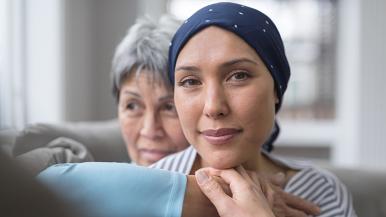From the awkward excitement of putting on your first training bra to the profound tenderness of nursing your first baby, you have a deeply personal relationship with your breasts. But when women are diagnosed with breast cancer, that relationship is forever changed.
"Decisions about breast surgery can be very complex and often very emotional," says Claudia Perez, DO, a breast surgeon at RUSH MD Anderson Cancer Center. "Our goal is optimizing oncologic safety, while still considering best cosmesis, and preserving femininity and your sense of self."
Surgery is considered the primary treatment for breast cancer; the only women who may not typically have surgery are those who have metastatic breast cancer that has spread to places like the liver or bones.
However, breast cancer is unique compared to other cancers that are treated surgically because there are more surgical options for breast cancer. Your doctors will educate you about your options, and you will work together to make a shared decision about the best surgical option for you.
Making that decision with confidence starts with knowing what you're up against and using that knowledge to make the best choice for yourself. These seven steps can help you get started.
1. Choose your own path.
Forty years ago, the only surgical option for treating breast cancer was a mastectomy (removal of the breast).
Today, mastectomy is typically done if you have more advanced breast cancer, if you are a smaller-breasted woman with a large breast tumor, or if you have a genetic mutation that increases your risk for cancer. And unlike several decades ago, you can choose to have breast reconstruction surgery, often at the time of your mastectomy, to rebuild the shape of your breast.
But some women with breast cancer can also choose a less invasive surgical option. Breast conservation (also known as lumpectomy) involves removal of the tumor and some breast tissue, while saving the rest of the breast and then treating the breast with radiation therapy. This may be a good choice if you have a less advanced stage of cancer.
In some instances, women with advanced breast cancer may actually be able to have a lumpectomy versus a mastectomy thanks to advances in targeted treatments designed to shrink breast tumors.
“For some women with large or more advanced tumors, we may first treat them with chemotherapy or anti-estrogen therapy to try to shrink the tumor,” Perez says. “If the tumor responds well to this treatment, we may be able to treat women with more advanced cancer with lumpectomy rather than mastectomy.”
2. Learn your chances of survival.
Your top concern after being diagnosed with breast cancer is curing the cancer. The good news is that your chances of survival are the same whether you opt for breast conservation or a mastectomy.
“I always emphasize to my patients that removing the entire breast does not improve their overall survival,” Perez says.
Also, whether or not you'll need additional treatments, such as chemotherapy and anti-hormone therapy, are typically the same regardless of which surgery you choose.
There is, however, a slightly higher risk that the breast cancer will return (also known as breast cancer recurrence) if you've had breast conservation because the remaining breast tissue can still be at risk.
3. Get the facts.
Having a mastectomy does not always mean removing both breasts. Yet more women today are choosing to have a double mastectomy, even if the cancer is just in one breast. While this may provide peace of mind, studies have found that a double mastectomy may lower your chance of recurrence, but it does not improve survival.
In fact, doctors typically only recommend having both breasts removed (also known as bilateral mastectomy) if you have breast cancer in both breasts or if you carry the BRCA1 or BRCA2 gene, which increases your risk of developing breast cancer.
4. Take your time.
Most breast cancers are relatively slow growing compared to many other types of cancer. That means if you need to think about it for a week or two or three, you can.
“Breast cancer may feel like an emotional emergency, but it’s not a surgical emergency where we need to get you into surgery the day you’re diagnosed,” Perez says. “It’s safe to take your time to make sure you’re making the best decision for yourself.”
Do your research, talk to women who have been through it — both mastectomy and breast conservation — and ask your doctor plenty of questions.
5. Ask about innovative treatments.
In addition to surgery, most women require some type of radiation.
One option for certain women is intraoperative radiation therapy (known as IORT), a one-time, concentrated radiation treatment you receive at the time of your lumpectomy. IORT is used to treat early-stage breast cancer and lower the risk of recurrence by targeting the area of the breast most at risk for recurrence, while sparing healthy tissue and organs.
If you receive a single dose of IORT, it is often the only radiation you will need.
6. Know that you can still have beautiful breasts.
“Many women are overwhelmed with anxiety once they hear the diagnosis of breast cancer," Perez says. "But once they hear the options, whether it is breast conservation or breast reconstruction, they feel reassured that there are options for beautiful breasts."
7. Explore your options for breast reconstruction.
Depending on your breast size and your cosmetic goals, there are some options for breast reconstruction:
- Reconstruction after mastectomy is available in two ways. You may choose to have breast reconstruction at the same time as your mastectomy. Or, you can have delayed breast reconstruction, a procedure in which your reconstruction may take place after your mastectomy.
- Nipple-sparing mastectomy is available to some women. During this procedure, your breast surgeon will remove all of the breast tissue without removing the nipple or areola. The surgeon hides the scar under the fold of the breast or in the lateral crease. This creates a very natural-looking breast.
- Implant procedures use saline or silicone gel-filled implants to reconstruct the shape and look of your breast. After the breast cancer surgeon removes the tumor and breast tissue, a plastic surgeon will place the implant under your chest muscles. You can have this procedure at the same time as your mastectomy, or after your mastectomy if you need radiation or other treatments.
- Microvascular tissue flap procedures, including DIEP flap, use tissue from your stomach, back, thighs or buttocks to rebuild the breast. These very complex procedures are done by a skilled plastic surgeon who specializes in microvascular breast reconstruction. Flap procedures have evolved in recent years, giving women more options and safer options than they had 10 years ago.
- Latissimus dorsi flap procedures uses muscle from your upper back to reconstruct your breast. This is often a good option for women who are not good candidates for the DIEP flap procedure.
- Oncoplastic breast reduction is a relatively new option for women having breast conservation surgery (lumpectomy). During this procedure, a breast cancer surgeon can remove the tumor and then often works as a team with a plastic surgeon to perform a breast reduction or lift for women who have large or sagging breasts.




